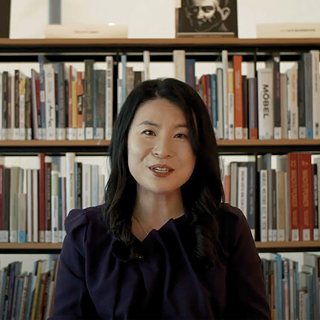Kafka & Graphic Novels
Please introduce yourself!
Hello, it's nice to meet all of you who are interested in Kafka and graphic novels. I’m Sunghwa Kim and research and teach about German literature, literature, and media, as well as graphic novels. In Germany, I am conducting a research project on Nicolas Mahler's graphic novels. I am interested in the relationships between literature and painting in everyday life. I also research graphic novels, comics, illustrations, and literature.Kafka's novels are often published as graphic novels. What do you think is the reason?
Kafka's novels are often adapted into graphic novels, comics, films, plays, and musicals. They continue to be popular in various countries, with artists such as Peter Cooper from the US and Eric Corbeyran from France creating graphic novel adaptations. Kafka's work, particularly “The Metamorphosis” is frequently illustrated, despite Kafka's reluctance to have the beetles in the story visually depicted.Kafka's work lends itself to different art forms, including graphic novels, because of his texts' symbolic nature. Kafka's writing is more metaphoric than logical and more intuitive than analytical, often relying on imagery. The inexplicability of the world in Kafka's work leaves space for interpretation, inspiring many graphic novel illustrators.
The rich and varied interpretations of Kafka's writings inspire graphic novel artists to express their understanding through images. In the same way that Kafka's works have been analyzed in writing, graphic novel artists feel that they, as readers of Kafka's works, bring their interpretations to life through visual images.
Among the many graphic novels with a Kafka connection, why did you concentrate on studying the comics by Nicolas Mahler?
I am delighted that you are interested in Nicolas Mahler. My research project focuses on German-language graphic novels, particularly the literary adaptations by the Austrian cartoonist Nicolas Mahler. In Korea, I presented the book “Kafka's nonstop Laughing Machine”, a humorous commentary on the negative social perceptions and prejudices against comics. In this work, the cartoonist shares his own autobiographical experiences as episodes.The inclusion of Kafka's name in the book's punchline is due to a comical mix-up between Kafka and the cartoonist “Kauka” in one of the episodes. The art of the cartoon and the social perceptions and prejudices of high and subculture are significant themes in the series. Overall, it's a clever exploration of the prejudices and social stigmatization of cartoons that Mahler himself frequently encounters.
"Wait a minute! Are comics a low form of culture?
Can comics not be considered literature?
How many points of contact are there between Kafka, one of the most prominent representatives of high culture, and Kauka, a cartoonist with a similar name who is considered part of the subculture?
In this comic, titled “Kafka and Kauka”, Nicolas Mahler cleverly portrays society's biases against comics and the life of a cartoonist in episodic form. I was particularly intrigued by the fact that he expresses prejudices against comics in the form of a comic book.
I found Mahler's perspective on the art of comics, the tension between literature and comics, and the contrast between high culture and subculture to be fascinating. One of the main focuses of my research is to examine, from a cultural-historical standpoint, what has led to the societal perception that cartoons are detrimental to education and an inferior, vulgar, and overly commonplace form of entertainment. I am particularly interested in exploring the role of comics, with the primary themes being social awareness and the future direction of comics.
Kafka dreamed of becoming a painter before he became a writer. Please recommend a book in which we can admire Kafka's paintings.
Kafka left behind a series of drawings, which were made known through his friend Max Brod. Brod, who also published Kafka's posthumous works, disregarded Kafka's wish to burn all his manuscripts after his death. Thanks to Brod's decision, we can admire Kafka's works today. Brod's notes reveal Kafka's lifelong interest in art and art history, including his childhood drawings. In 2021, C. H. Beck, a Munich-based publisher, released the complete collection of Kafka's drawings. This collection is an important resource that not only reflects Kafka's passion for art but also includes most of his drawings. I highly recommend this collection to anyone interested in Kafka's drawings.What is your favorite Kafka quote? Would you like to say a word to future readers who have not yet got to know Kafka?
There is a saying: “A book must be the axe for the frozen sea within us.” This sentence was mentioned in a letter that Kafka wrote to Oskar Pollak in 1904, and I will quote part of the letter: “I believe that one should only read books that bite and sting. If the book we are reading does not wake us up with a blow to the skull, why are we reading it? So that it makes us happy, as you write? My God, we would be happy even if we didn't have books, and we could write the books that make us happy ourselves if needed. But we need books that have an effect on us like a misfortune that hurts us very much, like the death of someone we would rather have than ourselves, like pushing into forests, away from all people, like a suicide, a book must be the axe for the frozen sea within us.”Of course, we can approach literature for pleasure, but I think that literature, like an axe, makes us face our lives. It makes us look at ourselves, rethink our hardened views on life, and change our lives. I think that is still the relevance of Kafka's work. In this year, the 100th anniversary of Kafka's death, I would like to recommend that you read Kafka's works warmly.
